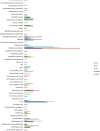Health care associated infections, antimicrobial resistance and outcomes in patients admitted to intensive care unit, India: A five-Year retrospective cohort study
- PMID: 37333868
- PMCID: PMC10273797
- DOI: 10.1177/17571774231161821
Health care associated infections, antimicrobial resistance and outcomes in patients admitted to intensive care unit, India: A five-Year retrospective cohort study
Abstract
Background: The present study was conducted to study the prevalence of HAIs in a newly established MICU, common microorganisms causing HAIs and their antibiotic-sensitivity profile, and antimicrobial utilization and mortality rate.
Methods: The present retrospective cohort study was carried out at AIIMS, Bhopal (2015-2019). The prevalence of HAIs was determined; sites of HAIs and common causative microorganisms were identified, and their antibiotic-sensitivity profiles were studied. The group of patients with HAIs was matched with a control group drawn from the pool of patients without HAIs; this matching was done with respect to age, gender, and clinical diagnosis. Antimicrobial utilization, Period of ICU stay, comorbidities and patient mortality rates in the two groups were analyzed. The clinical criteria by the CDC- National Nosocomial Infections Surveillance to diagnose HAIs.
Results: A total of 281 ICU patients' records were analyzed. The mean age was 47.21 ± 19.07 years. Of these 89 were found to have developed ICU-acquired HAIs (Prevalance:32%). Bloodstream infections (33%) and respiratory tract infections (30.68%), catheter-associated urinary tract infections (25.56%), and surgical site infections (6.76%) were the commonest. The most frequently isolated microorganism causing HAIs was K. pneumonia (18%), A. baumannii (14%) and E. coli (12%), 31% isolates of which were multidrug resistant. The average length of ICU stay was high in patients with HAIs (13.85 vs 8.2 days). The most common co-morbidity was type 2 diabetes mellitus (42.86%). Prolonged ICU stays [OR 1.13, (95% CI; 0.04-0.10)] and the presence of HAIs [OR 1.18(95%CI; (0.03-0.15)] were associated with an increased risk of mortality.
Conclusions: An increased prevalence of HAIs essentially bloodstream infections and respiratory infections with MDR organisms to antimicrobials in the watch group is highly considerable. Acquisition of HAIs with MDR organisms and increased length of hospital stay are considerable risk factors for increased mortality in ICU-admitted patients. Regular antimicrobial stewardship activities and revising existing hospital infection control policies accordingly may reduce HAIs.
Keywords: Intensive care unit; Nosocomial infections; antimicrobial resistance; hospital aquired infection; respiratory tract infections.
© The Author(s) 2023.
Conflict of interest statement
The author(s) declared no potential conflicts of interest with respect to the research, authorship, and/or publication of this article.
Figures
Similar articles
-
Nosocomial infections in the medical ICU: a retrospective study highlighting their prevalence, microbiological profile and impact on ICU stay and mortality.J Assoc Physicians India. 2014 Oct;62(10):18-21. J Assoc Physicians India. 2014. PMID: 25906516
-
Device associated -health care associated infections monitoring, prevention and cost assessment at intensive care unit of University Hospital in Poland (2015-2017).BMC Infect Dis. 2020 Oct 16;20(1):761. doi: 10.1186/s12879-020-05482-w. BMC Infect Dis. 2020. PMID: 33066740 Free PMC article.
-
Epidemiology and Microbiological Profile of Common Healthcare Associated Infections among Patients in the Intensive Care Unit of a General Hospital in Kuwait: A Retrospective Observational Study.J Epidemiol Glob Health. 2021 Sep;11(3):302-309. doi: 10.2991/jegh.k.210524.001. Epub 2021 Jun 5. J Epidemiol Glob Health. 2021. PMID: 34270184 Free PMC article.
-
Healthcare-associated infections in Africa: a systematic review and meta-analysis of point prevalence studies.J Pharm Policy Pract. 2022 Dec 9;15(1):99. doi: 10.1186/s40545-022-00500-5. J Pharm Policy Pract. 2022. PMID: 36494700 Free PMC article. Review.
-
Hospital-acquired and zoonotic bacteria from a veterinary hospital and their associated antimicrobial-susceptibility profiles: A systematic review.Front Vet Sci. 2023 Jan 9;9:1087052. doi: 10.3389/fvets.2022.1087052. eCollection 2022. Front Vet Sci. 2023. PMID: 36699325 Free PMC article.
Cited by
-
Prescribing trends and rational drug use patterns in cardiovascular patients: A cross-sectional observational study.Bioinformation. 2024 Nov 30;20(11):1582-1587. doi: 10.6026/9732063002001582. eCollection 2024. Bioinformation. 2024. PMID: 40162464 Free PMC article.
References
-
- Benenson AS. (1995) Control of Communicable Diseases Manual. 16th edition. Washington, DC, USA: American Public Health Association.
-
- Chawla R. (2008) Epidemiology, etiology, and diagnosis of hospital-acquired pneumonia and ventilator-associated pneumonia in Asian countries. American Journal of Infections and Control 36: 93–100. - PubMed
-
- Chenchula S, Gupta R, Sadasivam B, et al. (2018) In vivo resistance to ceftriaxone in enteric fever": In a tertiary care teaching hospital, Central India. International Journal of Innovative Research in Medical Science 3: 124–125.
LinkOut - more resources
Full Text Sources


